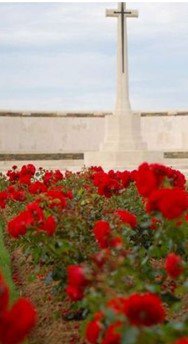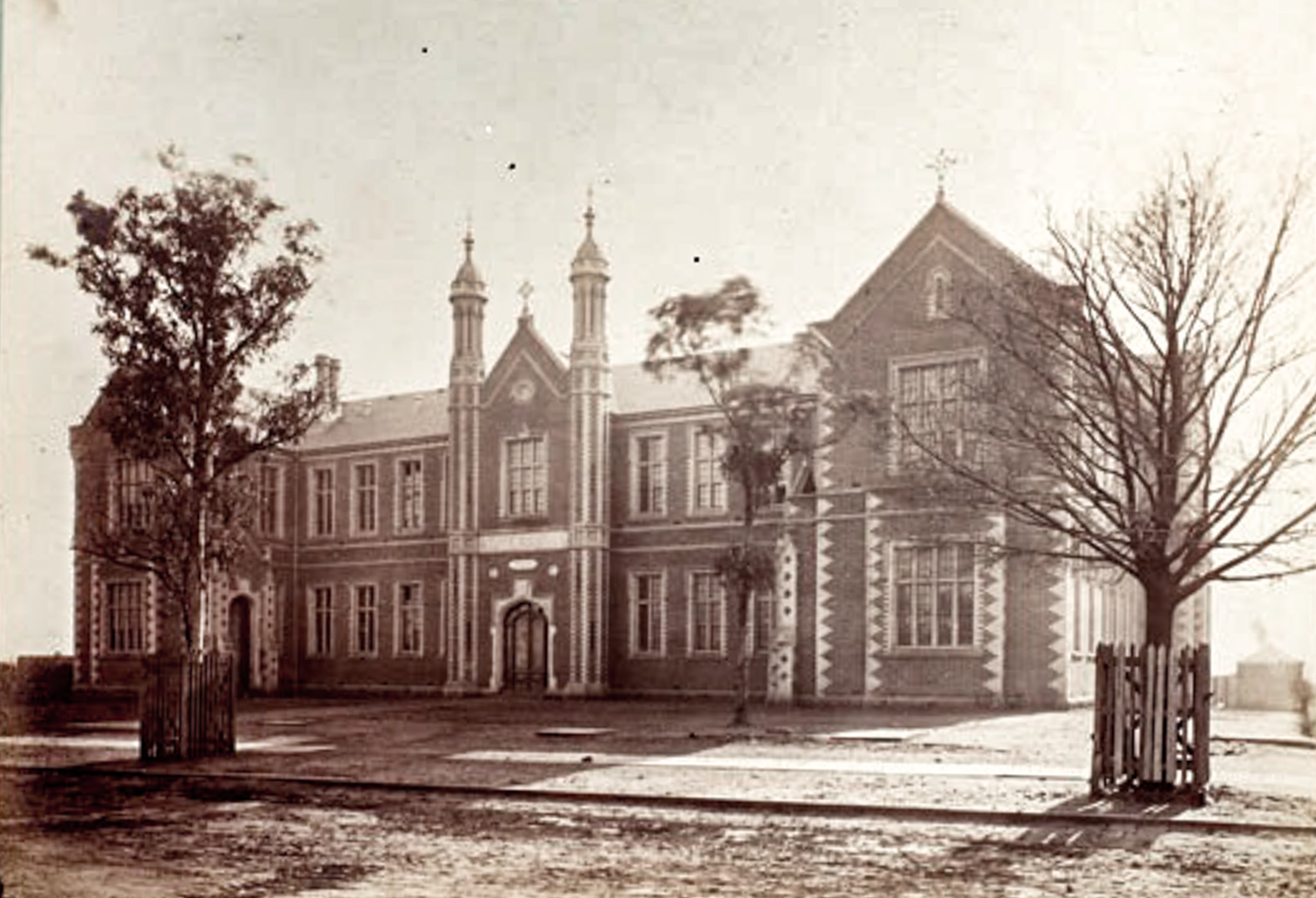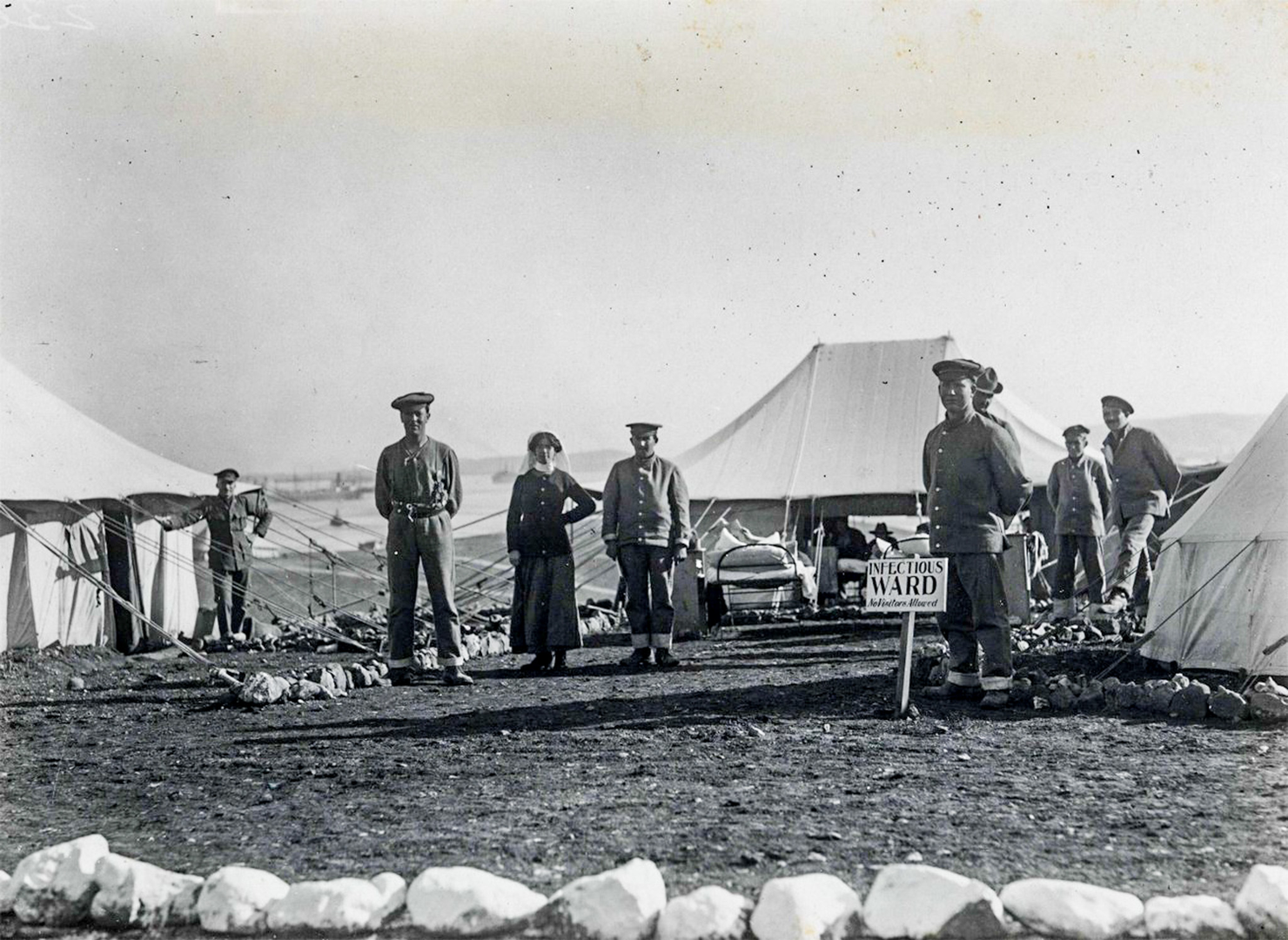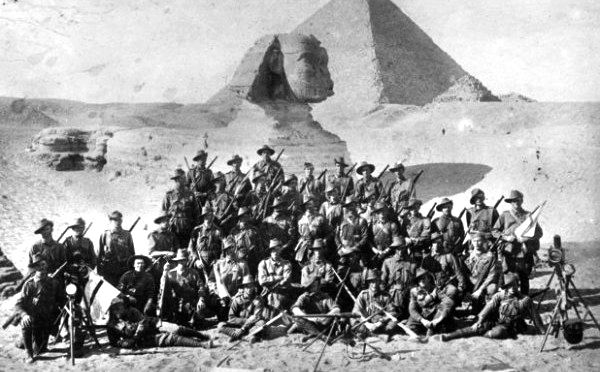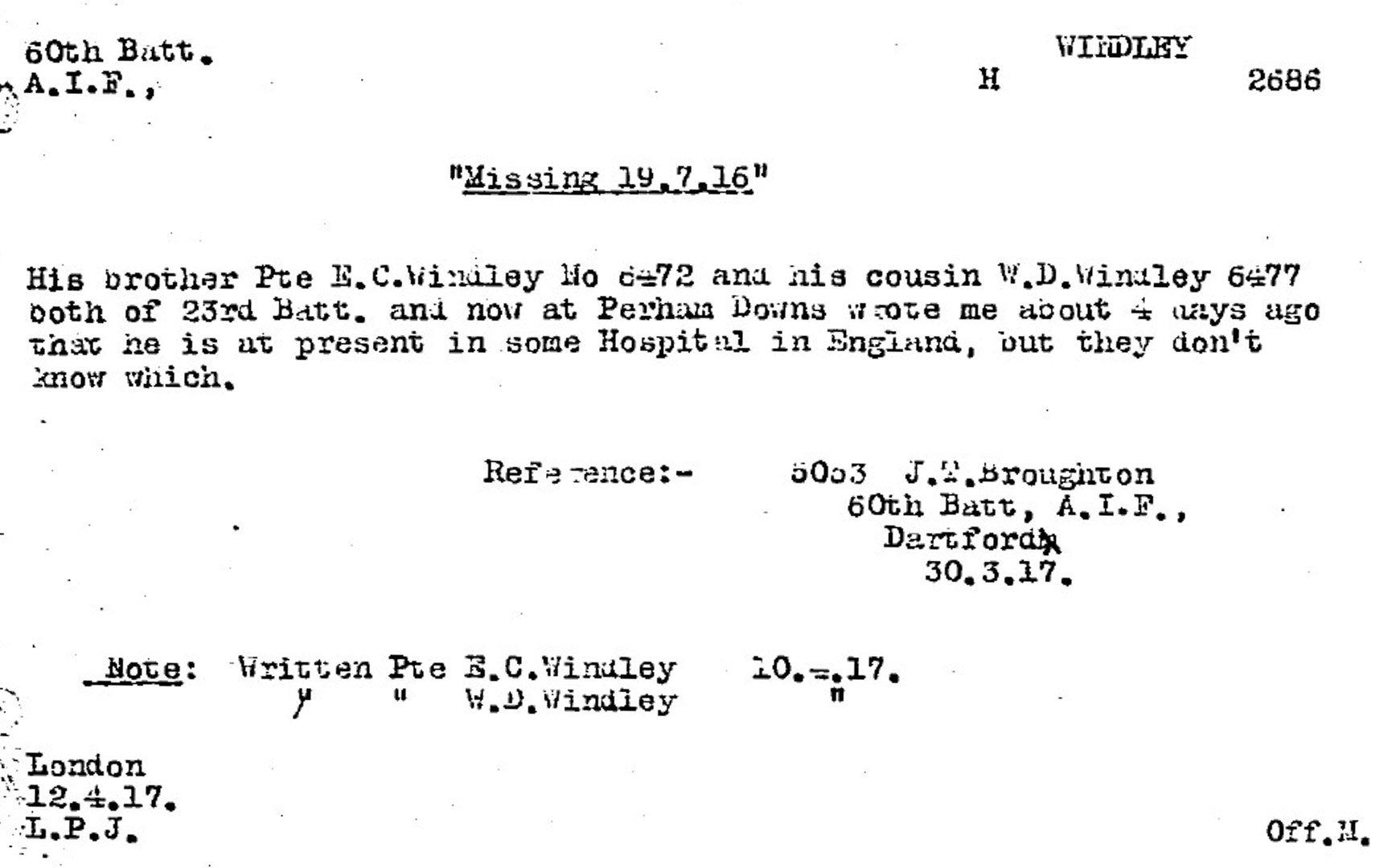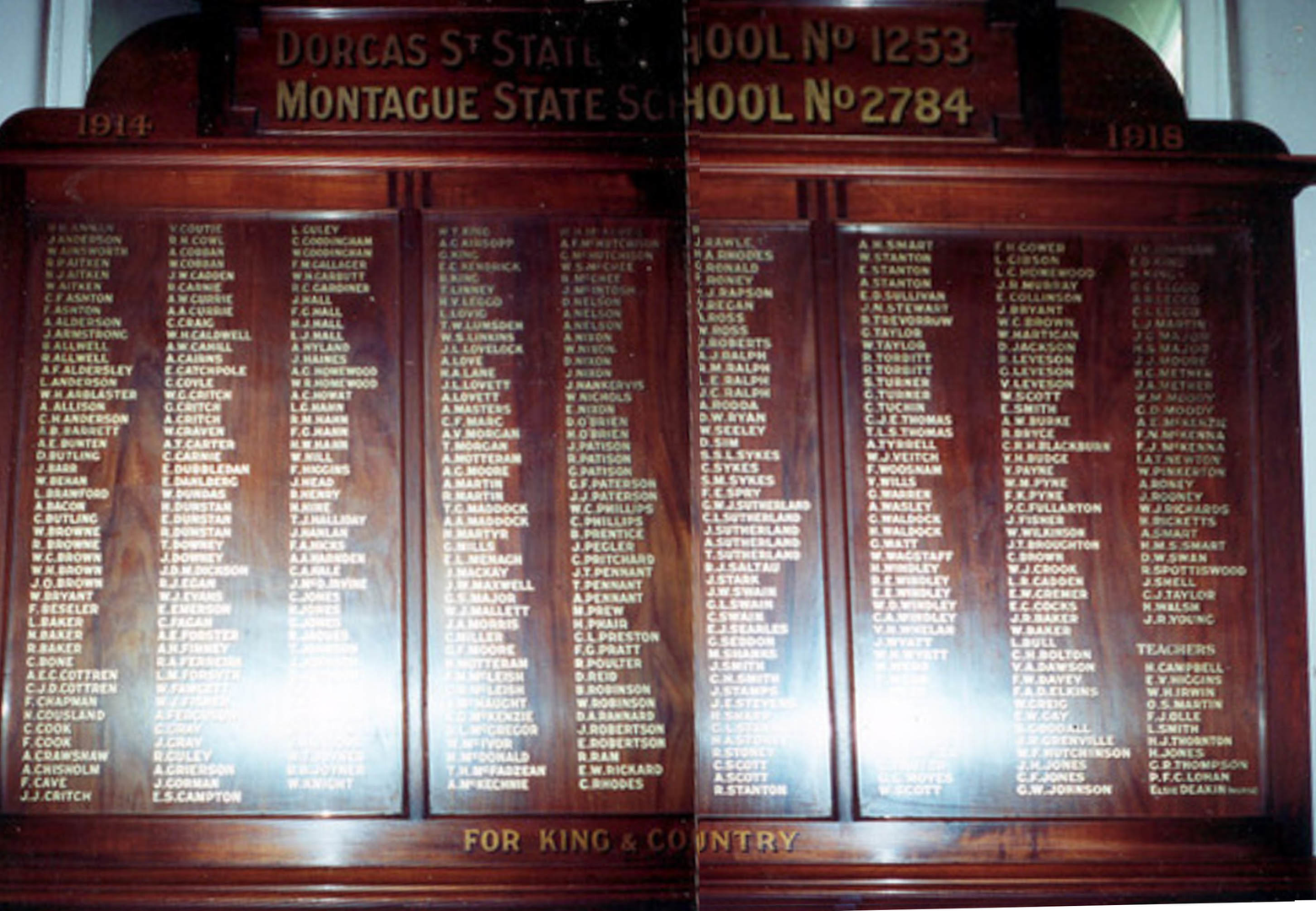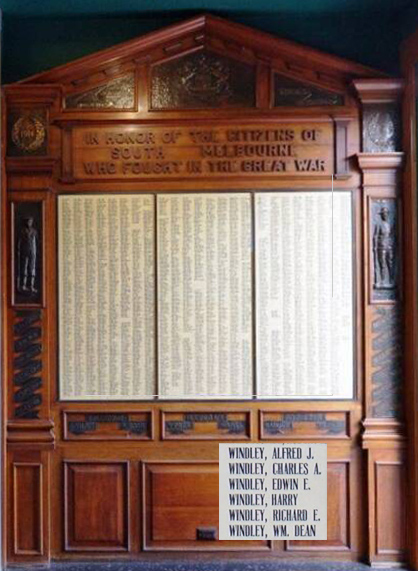Harry WINDLEY
Eyes blue, Hair dark brown, Complexion dark
Harry Windley – A South Melbourne Son
Can you help us identify Harry?
Harry Windley’s body was never found after the Battle of Fromelles, and there are no records of his burial. A mass grave was found in 2008 at Fromelles, a grave the Germans dug for 250 Australian soldiers they recovered after the battle.
As of 2024, 180 of these soldiers have been able to be identified via DNA testing. Harry may be among these remaining 70 unidentified men. There is still a chance to identify him — but we need help.
We welcome all branches of his family to come forward to donate DNA to help with his identification, especially those with roots in South Melbourne, VIC.
See the DNA box at the end of the story for what we do know about his family. If you know anything of contacts for Harry, please contact the Fromelles Association.
Early Life
Harry Windley was born in South Melbourne in 1896, the eldest son of Harry Windley (1870–1944) and Cornelia Mary Hawken (1877–1945). Cornelia’s parents migrated from Pengelly in Cornwall while Harry’s (sr.) father came from Leicester England in 1849, and mother from Tipperary, Ireland.
They had the following children:
- Harry 1896-1916
- George 1898-1904 (died aged 6)
- Clement 1899
- Cecil 1901
- Vincent 1907-1908 (died infancy)
- Clive 1908-1981
- Alma 1912
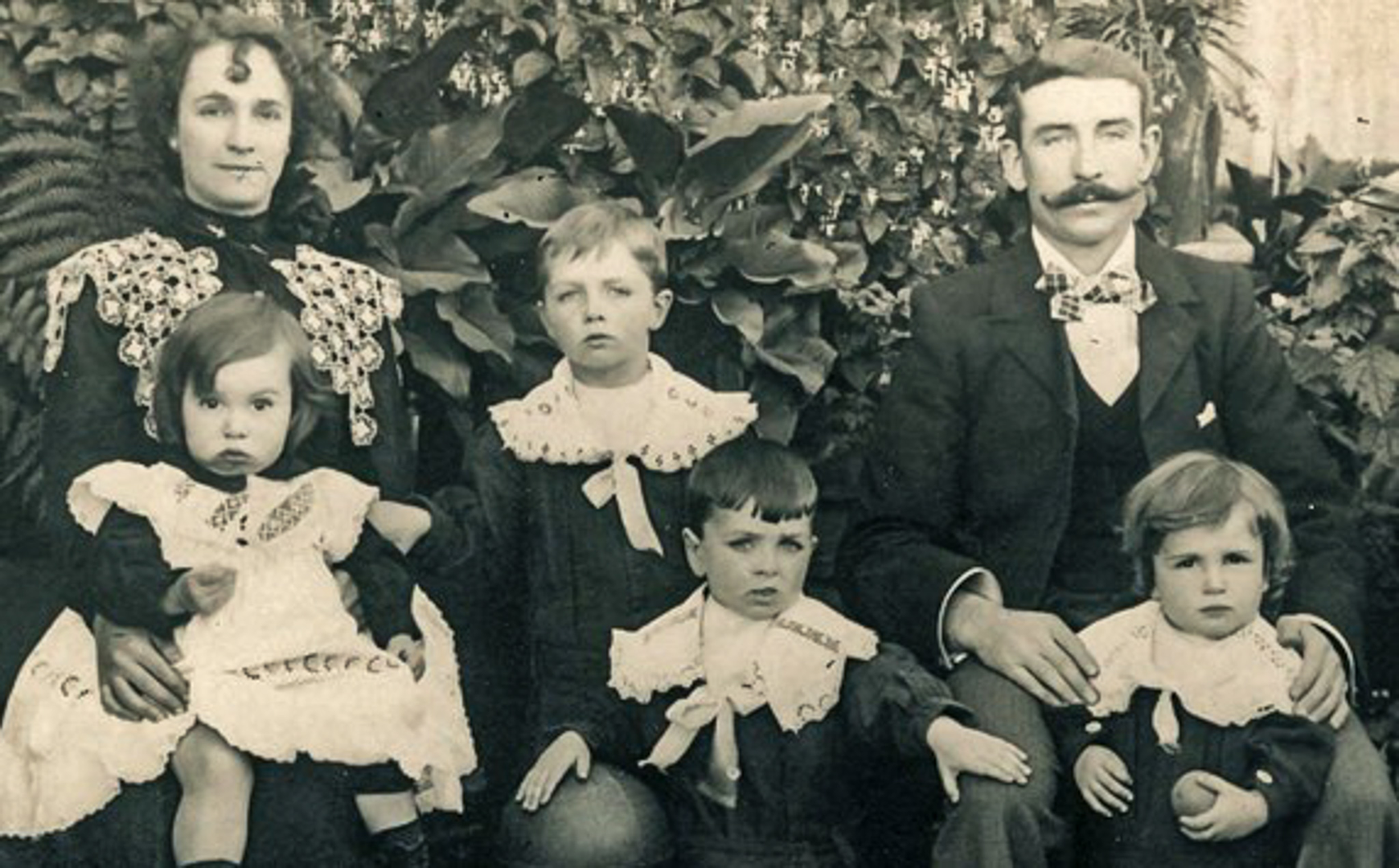
Harry’s father was a newspaper man for 60 years, working for the Melbourne Leader and later the Melbourne Age. The Melbourne Leader had been founded in 1855 by George M. Dow and emerged as a significant voice in Victoria, Australia. Initially a newspaper catering to the working class, it evolved over the decades into a credible source of investigative journalism and community engagement, reporting on major events like the gold rush and crucial political changes.
Source: https://www.oldnews.com/en/newspapers/australia/victoria/melbourne/the-melbourne-leader
The Windley children attended Dorcas Street State School, only a short walk from the family home in Ferrars Street. In 1918 that school closed and another opened across the road at Ferrars St, so very convenient for the younger cildren. (The beautiful Dorcas street building is now a luxury apartment building.)
Harry’s family was very well known in the inner suburbs of Melbourne, particularly in the community around Albert Park and South Melbourne. The Windley family carried a strong sporting tradition. Harry’s father, was a prominent footballer for the South Melbourne Football Club in the 1890s, following his brother “Billy” Windley, who captained the team in 1896 and was remembered as one of South’s champions.
Both father and uncle featured in Melbourne newspapers of the day, with portraits published as part of football coverage. This family was immersed in the sporting culture of South Melbourne.
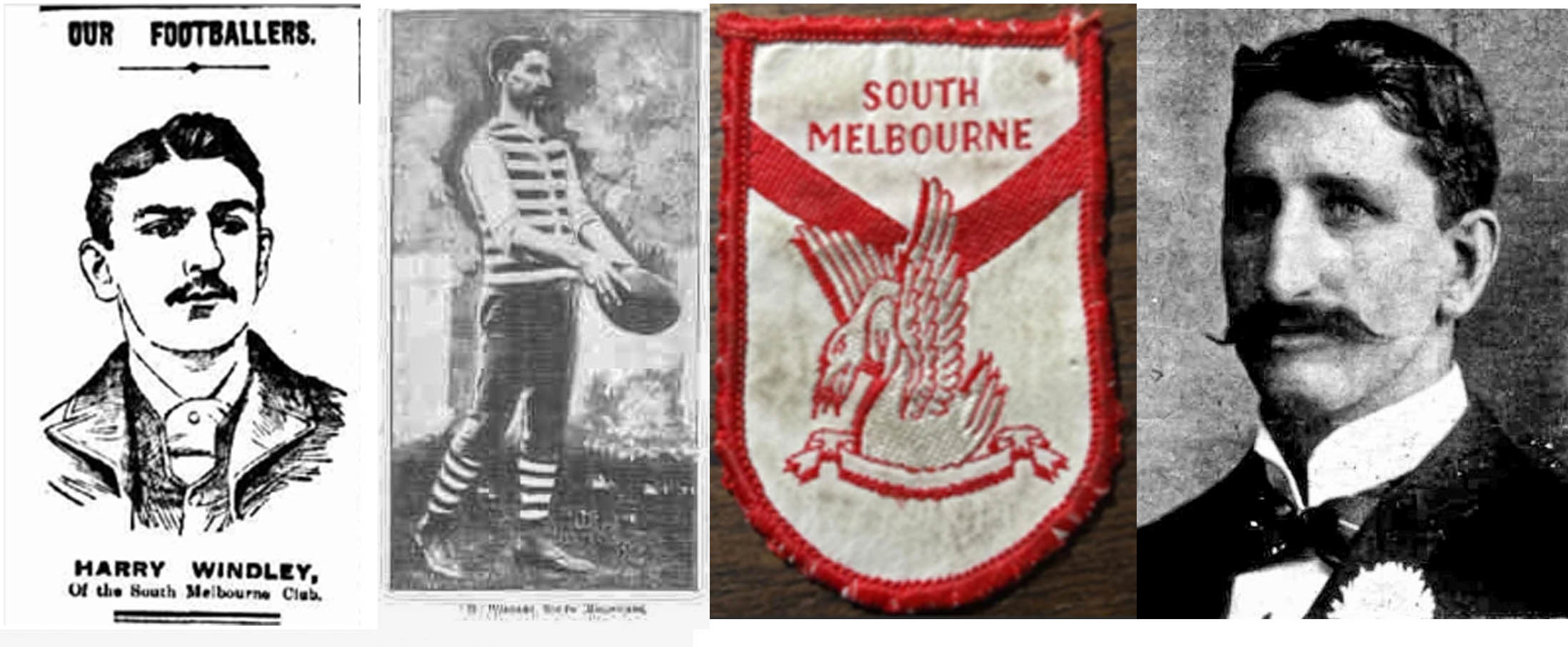
Father Harry Windley, Our Footballers – Harry Windley (South Melbourne). (29 July 1892). The Herald (Melbourne, Vic. : 1861–1954), p.3. http://nla.gov.au/nla.news-article242874201
Senior Football Captains – W. Windley, South Melbourne. (2 May 1896). The Australasian (Melbourne, Vic. : 1864–1946), p.25. http://nla.gov.au/nla.news-article139725164
South Melbourne “Swans Badge crica 1900
Uncle Billy Windley, https://en.wikipedia.org/wiki/Bill_Windley
Harry’s extended family were equally prominent and also enlisted. His Windley cousins – five brothers - all served in the First World War:
- Alfred John (1112) Flying Corps,
- Charles (7586) 7th Btn,
- William Dean (6477) 23rd btn,
- Richard Ely (6905) 23rd Btn,
- And Edwin Ernest Windley (6472) 23rd btn
Along with cousin Alfred Windley Capp (39620) 12th Field Artillery – all returned. The Windley name would appear multiple times on the South Melbourne Roll of Honour, a tribute to one family’s service and sacrifice. Before enlistment, Harry worked as a steward. He had already served four years as a Lieutenant in the Senior Cadets (Area 52) and a year in the Citizen Military Forces (52nd Battalion), experience that gave him a grounding in military life even before he reached the legal age to enlist.
Off to War
By mid-1915, Harry was eager to enlist, despite being only just 18 years old. His youngest sibling then only two. Like many underage volunteers, he required the written consent of his parents. On 11 June 1915, his mother Cornelia Mary Windley signed a note granting permission:
“I hereby give my consent that my son Harry enlist and fight for his King & Country.”— Signed Cornelia Mary Windley and H. Windley
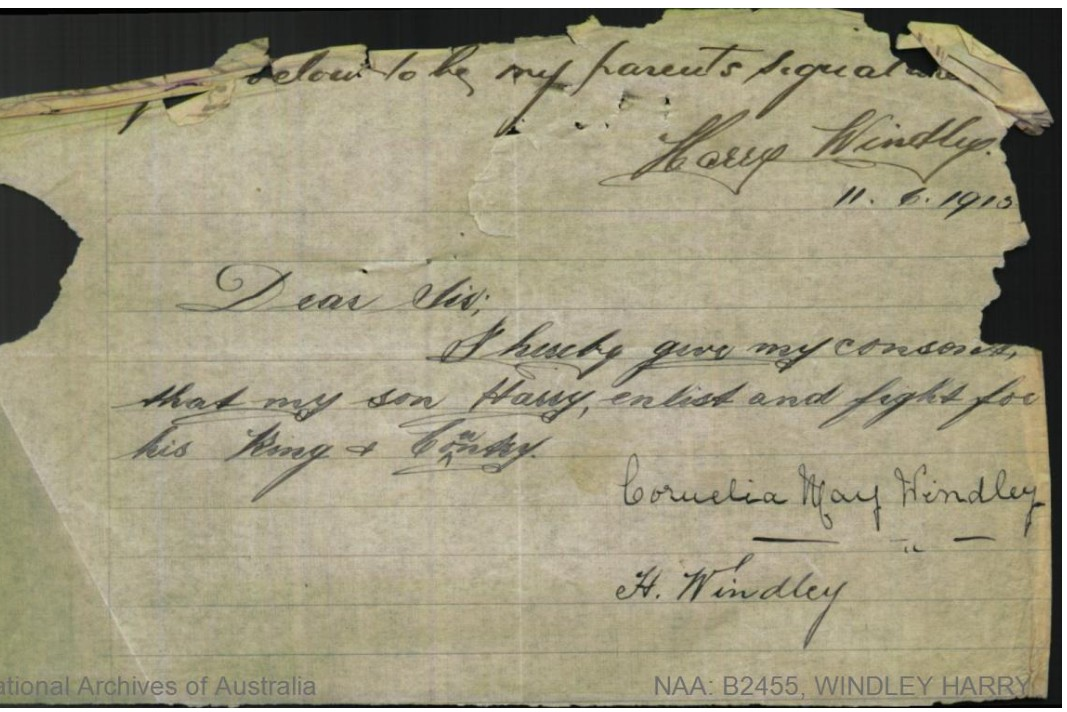
With his parents’ consent secured, Harry enlisted in Melbourne on 14 June 1915 and was posted as a Private to the 7th Battalion, 8th Reinforcement. He embarked from Melbourne aboard HMAT A68 Anchises on 26 August 1915, bound first for the Gallipoli campaign. His initial months overseas were marked by illness. Heading for Gallipoli, he was admitted to the Anzac Advanced Base, at Mudros on the island of Lemnos (Greece) in November 1915. In January family received he telegam that he was seriously ill with pleurisy. In February he was convalescent. Then another telegram to say he had mumps in March, in Cairo.
It was common for the younger soldiers to have less resistance to infection. Soldiers died from illness as well as combat. The wards were tents with poor conditions on Lemnos in winter. Pleurisy kept recurring from then and during his first months in Egypt. By March he had mumps as well and transferred to a convalescent camp in April, his parents must have been very concerned at this time.
Late in March, Harry was transferred to the 58 battalion, and then 2 weeks later found himself with the 60th - no doubt he was with many of the same mates and officers he had been with since embarking. Benefitting from the warmth of Egypt, Harry was back to normal duties and part of Brigadier General “Pompey” Elliott’s 15th Brigade. The battalion was made up of Gallipoli veterans and new reinforcements, some even less experienced than Harry, but eager for their first action.
On 18 June 1916, they embarked from Alexandria for France with the British Expeditionary Force, disembarking at Marseilles on 29 June 1916. Less than three weeks later, he would be in the front lines preparing for what would become one of the AIF’s darkest days — the Battle of Fromelles.
The Battle of Fromelles
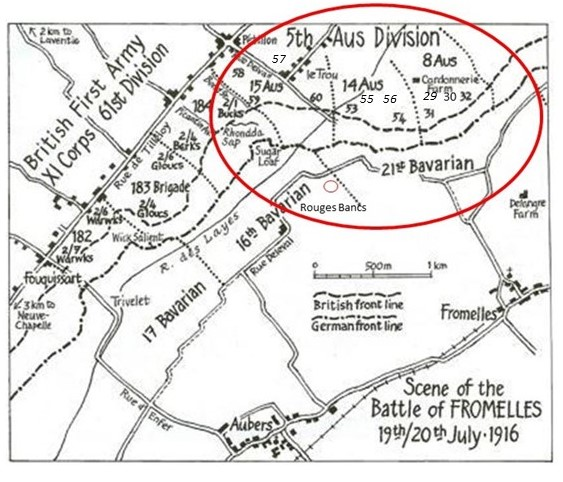
The battle plan had the 15th Brigade located just to the left of the British Army. The 59th and 60th Battalions were to be the lead units for this area of the attack, with the 58th and 57th as the ‘third and fourth’ battalions, in reserve. The main objective for the 15th Brigade was to take the trenches to the left of a heavily armed, elevated German defensive position, the ‘Sugar Loaf’, which dominated the front lines. If the Sugar Loaf could not be taken, the other battalions would be subjected to murderous enfilade fire from the machine-guns and counterattacks from that direction.
As they advanced, they were to link up with the 59th and 53rd Battalions on their flanks. The 60th Battalion faced an especially difficult position in the assault, directly opposite from the ‘Sugar Loaf’ . On 17 July, they were in position for the major attack against the Sugar Loaf position, but it was postponed due to unfavourable weather. There was a gas alarm, but luckily it was just that.
Two days later, Zero Hour for advancing from their front-line trenches was to be 5.45 PM, but the Germans knew this attack was coming and were well-prepared. They opened a massive artillery bombardment on the Australians at 5.15 PM, causing chaos and many casualties.
A fellow soldier, Private Bill Boyce (3022, 58th), summed the situation up well:
“What have I let myself in for?”
The Aussies went over the parapet at 5:45 PM in four waves at 5 minute intervals, but then lay down to wait for the support bombardment to end at 6 PM. A & B Companies were in the first two waves, C & D in the next two. Casualties were immediate and heavy. The 15th Brigade War Diaries captures the intensity of the early part of the attack – “they were enfiladed by machine guns in the Sugar Loaf and melted away.”
The British 184th Brigade just to the right of the 59th met with the same resistance, but at 8.00 PM they got orders that no further attacks would take place that night. However, the salient between the troops limited communications, leaving the Australians to continue without British support from their now exposed right flank. It was reported that some got to within 90 yards of the enemy trenches. One soldier said he “believed some few of the battalion entered enemy trenches and that during the night a few stragglers, wounded and unwounded, returned to our trenches.”
Source: AWM4 23/77/6, 60th Battalion War Diaries, July 1916, page 3
Fighting continued through the night. With known high casualties in the 60th, they were relieved by the 57th Battalion at 7.00 AM. Roll call was held at 9.30 AM.
In the ‘Official History of the War’, C.W. Bean said:
“of the 60th Battalion, which had gone into the fight with 887 men, only one officer and 106 answered the call.”
To get some perspective of the battle, when Charles Bean, Australia’s official war historian, attended the battlefield two and half years later, he observed a large quantity of bones, torn uniforms and Australian kit still on the battlefield.
The final impact of the battle on the 60th was that 395 soldiers were killed or died of wounds, of which 315 were not able to be identified. Harry was among those who never returned. He was reported missing in action on 19 July 1916, and like so many families, his parents and relatives clung to any scrap of hope.
After the Battle
Despite the Army and Red Cross’ efforts, given the extent of the battle, information about missing soldiers was difficult to obtain and potentially misleading. Neverthless, ANY news back to the families was greatly welcomed. For the Windley family, Harry’s fate remained uncertain for more than a year. With Harry reported missing in action after the Battle of Fromelles, they endured long months of rumours and conflicting reports.
In March 1917, Private J.T. Broughton (5053) from South Melbourne reported a ‘good’ outcome - “His brother Pte Ernest E. Windley and his cousin William.D. Windley … wrote me about 4 days ago that he is at present in some hospital in England, but they don’t know which.” (note – Harry’s cousins Ernest and William were brothers).
A few months later, his cousin Private Edwin Ernest Windley (6472) of the 67th Battalion wrote from England:
“So far we have not yet heard of him … in Australia they received news saying that he was reported in hospital somewhere about last Feb. or March. But if you should happen to hear anything of him I should be very pleased to receive any information which would lead me to communicate with him.”
Such rumours and fragments of hope were common in the aftermath of Fromelles, when so many men vanished without trace. Despite these glimmers of hope, a Court of Enquiry held in the field on 4 August 1917 declared Harry to have been killed in action on 19 July 1916.
The official death notice did not appear until 31 August 1917, over a year later:
“WINDLEY. — Killed in action in France, 19th July, 1916 (previously reported missing), Private Harry Windley, beloved eldest son of H. and C. Windley, and brother of Clement, Cecil, Clive and Alma, aged 21 years.”
Even after the ruling, Harry’s parents struggled with the lack of closure. In a letter dated 1921, his father wrote to Base Records:
“The only information we have received of our son was from the Defence Dept. He was at first reported to be ‘missing’ and about twelve months later was reported ‘killed in action’ on the 19th July 1916. We have received none of his belongings, and the only thing that we are certain of is that he was killed in the Fleurbaix engagement, in France, on the above date, and it was there that he was last seen alive.”
Family
The death of Harry at Fromelles in 1916 cast a long shadow over the Windley family. His parents, Harry and Cornelia, endured not only the grief of losing their eldest son, but further misfortune in the years that followed. Harry’s brothers met with mixed fates.
At 18, Clement (“Clem”) survived, but in 1918 he was badly injured in a dynamite cap explosion, losing his right hand and part of his left.
Cecil, a cabinetmaker, died in a cycling accident in 1939, leaving behind a widow and three children.
The extended Windley family also carried a heavy burden throughout the war. Harry’s cousins — Alfred, Charles, William, Richard, and Edwin — all served in the First World War. Richard Ely, one of the Rats of Tobruk, who had returned from France in 1919, later re-enlisted in the Second World War and was killed in Egypt in 1942. Both parents lived long enough to feel the full weight of these losses.
Harry senior, once a prominent South Melbourne footballer and long-serving staff member at The Age, died in 1944 at his home in Albert Park. Cornelia followed in 1945. The Windley family’s name is inscribed across Melbourne memorials.
Harry is remembered at the South Melbourne Roll of Honour alongside his cousins, and on the Dorcas Street State School Honour Roll. Together, their names tell a story of sacrifice that stretched across two world wars, and of a family deeply marked by loss. Harry was awarded the 1914-15 Star Medal, the British War Medal, the Victory Medal, a Memorial Plaque and a Memorial Scroll.
He is commemorated at:
- V.C. Corner Australian Cemetery Memorial, Fromelles, France – with 410 Australians who have no known grave.
- Australian War Memorial, Canberra – Roll of Honour, Panel 171.
- South Melbourne Roll of Honour – listed together with his cousins Charles, William, Richard, and Ernest Windley.
- Dorcas Street State School Honour Roll (South Melbourne) – his old school, where former pupils who served are remembered.
Finding Harry
Harry’s remains were not recovered, he has no known grave. After the battle, the Germans recovered 250 Australian soldiers and placed them in a burial pit at Pheasant Wood. This grave was discovered in 2008 and since then efforts have been underway to identify these soldiers by DNA testing from family members. As of 2024, 180 of the soldiers have been identified, including two of the 315 unidentified soldiers from the 60th Battalion.
We welcome all branches of Harry’s family to come forward to donate DNA to help with his identification. If you know anything of family contacts, especially those with roots in Victoria and those from the Hawken maternal line, please contact the Fromelles Association. We hope that one day Harry will be named and honoured with a known grave.
Please visit Fromelles.info to follow the ongoing identification project and Harry’s story.
DNA samples are being sought for family connections to
| Soldier | Harry Windley (1896–1916) |
| Parents | Harry Windley (1870–1944), born Victoria, died Albert Park, Vic; Cornelia Mary Hawken (1877–1945), born South Melbourne, Vic, died Richmond, Vic |
| Siblings | George Rudall (1898–1904) | ||
| Clement Percy Buckingham “Clem” (1899–1979) | |||
| Cecil Herman (1900–1939) m Joyce Hanson | |||
| Vincent Oswald (1907–1908) | |||
| Clive (1908–1981) m Olive Bradshaw | |||
| Alma Harriet Male (1912–1963) m Ronald Horne |
| Grandparents | |||
| Paternal | Alfred John Windley (1829–1872), Leicester, England – South Melbourne, Vic; Ann Catherine Moroney (1837–1905), Ireland – Victoria | ||
| Maternal | William Hawken (1836–1905), Cornwall, England – Victoria; Jane Ann Male (1839–1923), Cornwall, England – Victoria |
Links to Official Records
Seeking DNA Donors

Contacts
(Contact: carla@fromelles.info or geoffrey@fromelles.info).
(Contact: army.uwc@defence.gov.au or phone 1800 019 090).
Donations
If you are able, please contribute to the upkeep of this resource.
(Contact: bill@fromelles.info ).
